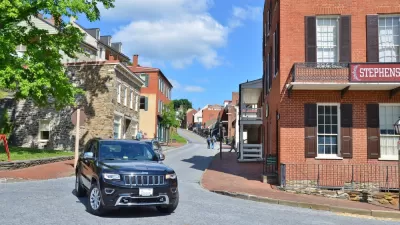While much focus is on the future of autonomous vehicles, the increase in pedestrian deaths related to SUVs remains a largely ignored issue.

Recent debates about self-driving vehicles and public safety have overshadowed the long-standing issue of SUVs, writes Henry Grabar. The overall number of traffic fatalities decreased in 2018, but pedestrian and cyclist deaths are on the rise. More SUVs are on the road, and that is part of the problem, says Grabar:
In February, the Governors Highway Safety Association estimated that more than 6,200 pedestrians died in 2018—the highest number in a generation, and an increase of 50 percent from 2009. The GHSA says SUVs are partially responsible: Their involvement in fatal crashes is up 50 percent, compared with 30 percent for sedans.
The National Highway Traffic Safety Administration has known for years that the weight, higher bumpers, and limited visibility of SUVs mean pedestrians are more likely to be killed when struck by the vehicles. "The regulators did nothing. If another product saw its nonuser death count spike by 50 percent in 10 years, consumers would revolt and Congress would make a big show of getting to the bottom of it. Automobiles are different," argues Grabar.
Regulation in Europe—where SUV sales are up, but pedestrian deaths decreased by over a third between 2007 and 2016— could provide some clues for the U.S., notes Grabar. Safety assessments of European vehicles include a "vulnerable road users" criterion. "In America, by contrast, NHTSA ratings have three primary categories: frontal crash, side crash, and rollover. What happens to the people you hit? Who knows."
FULL STORY: Don’t Count on U.S. Regulators to Make Self-Driving Cars Safe for Pedestrians

Planetizen Federal Action Tracker
A weekly monitor of how Trump’s orders and actions are impacting planners and planning in America.

Map: Where Senate Republicans Want to Sell Your Public Lands
For public land advocates, the Senate Republicans’ proposal to sell millions of acres of public land in the West is “the biggest fight of their careers.”

Restaurant Patios Were a Pandemic Win — Why Were They so Hard to Keep?
Social distancing requirements and changes in travel patterns prompted cities to pilot new uses for street and sidewalk space. Then it got complicated.

Albuquerque Route 66 Motels Become Affordable Housing
A $4 million city fund is incentivizing developers to breathe new life into derelict midcentury motels.

DC Area County Eliminates Bus Fares
Montgomery County joins a growing trend of making transit free.

Platform Pilsner: Vancouver Transit Agency Releases... a Beer?
TransLink will receive a portion of every sale of the four-pack.
Urban Design for Planners 1: Software Tools
This six-course series explores essential urban design concepts using open source software and equips planners with the tools they need to participate fully in the urban design process.
Planning for Universal Design
Learn the tools for implementing Universal Design in planning regulations.
Heyer Gruel & Associates PA
JM Goldson LLC
Custer County Colorado
City of Camden Redevelopment Agency
City of Astoria
Transportation Research & Education Center (TREC) at Portland State University
Camden Redevelopment Agency
City of Claremont
Municipality of Princeton (NJ)





























